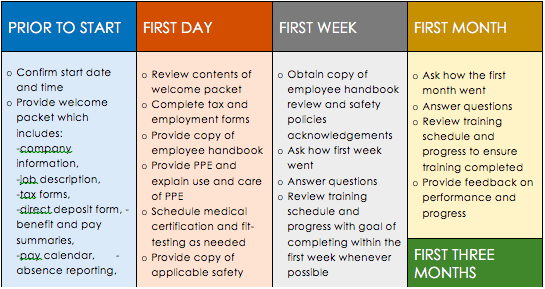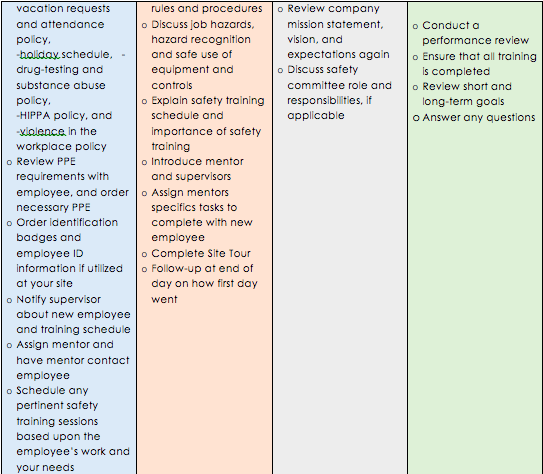Many companies do not have a fully integrated onboarding process and many more claim that it is too time-consuming or expensive to completely train employees on all safety and employment policies before the employee begins work. However, the research finds that proper onboarding is a powerful tool in managing new employee effectiveness and long-term success. Employees who understand company policies and their role within the organization are more productive, report higher job satisfaction, and stronger commitment to the organization. Who doesn’t want happier, more productive and committed employees?
Happier, more productive and committed employees often translate into lower turnover and a better work product, which in turn increases your company’s bottom line. Thus, a small but committed investment upfront can yield dividends for your company down the line.
How to Maximize Your Onboarding Process
The most important day on the job for a new employee is the first day – so make the first day count. The old adage says that you never get a second chance to make a first impression.
Proper onboarding can help make a good first impression. It also sets the tone on your expectations for new employees and helps them get acclimated to your way of doing business more quickly. Proper onboarding does not just include a completion of initial employment paperwork and a short welcome video, but is rather a systematic approach to ensuring that employees have all the tools and information they need to be successful at their new job.
With some advanced planning, onboarding does not need to be time-consuming or expensive and, if done correctly, it can reduce confusion, errors and unproductive downtime. So how does your company set up an effecting onboarding program?
- First, develop a written onboarding plan.
The Plan should provide an outline that reviews all policies and procedures that employees should be informed of and trained on, the specific timeline for completing the onboarding process, how employees will be trained, and the identity of all parties responsible for completing each task.
The Plan helps ensure employees receive all the trainings they should and reduces the chance that something (and thus someone) will fall through the cracks. The Plan also helps employers hold managers and supervisors accountable and makes clear that they share a role in any new employee’s success.
To streamline the process, many of the standard Human Resource notifications and Tax forms can be given to a new employee and completed before their first day, which will reduce the time spent waiting for the employee to review and complete those materials and will get them working on the job sooner.
- Second, designate specific intervals for check-in meetings with the new employee.
Use these meetings as an opportunity to ensure the employee has completed all the necessary trainings and paperwork.
During these meetings, give employees an opportunity to ask questions and provide feedback on the process and how they are adjusting. These meetings do not have to be long – 15 to 20 minutes may be enough. The meetings do not have to be formal either – a simple check-in with the boss can make an employee feel valued and help boost morale.
Many companies do not have a fully integrated onboarding process and many more claim that it is too time-consuming or expensive to completely train employees on all safety and employment policies before the employee begins work. However, the research finds that proper onboarding is a powerful tool in managing new employee effectiveness and long-term success. Employees who understand company policies and their role within the organization are more productive, report higher job satisfaction, and stronger commitment to the organization. Who doesn’t want happier, more productive and committed employees?
Happier, more productive and committed employees often translate into lower turnover and a better work product, which in turn increases your company’s bottom line. Thus, a small but committed investment upfront can yield dividends for your company down the line.
How to Maximize Your Onboarding Process
The most important day on the job for a new employee is the first day – so make the first day count. The old adage says that you never get a second chance to make a first impression.
Proper onboarding can help make a good first impression. It also sets the tone on your expectations for new employees and helps them get acclimated to your way of doing business more quickly. Proper onboarding does not just include a completion of initial employment paperwork and a short welcome video, but is rather a systematic approach to ensuring that employees have all the tools and information they need to be successful at their new job.
With some advanced planning, onboarding does not need to be time-consuming or expensive and, if done correctly, it can reduce confusion, errors and unproductive downtime. So how does your company set up an effecting onboarding program?
- First, develop a written onboarding plan.
The Plan should provide an outline that reviews all policies and procedures that employees should be informed of and trained on, the specific timeline for completing the onboarding process, how employees will be trained, and the identity of all parties responsible for completing each task.
The Plan helps ensure employees receive all the trainings they should and reduces the chance that something (and thus someone) will fall through the cracks. The Plan also helps employers hold managers and supervisors accountable and makes clear that they share a role in any new employee’s success.
To streamline the process, many of the standard Human Resource notifications and Tax forms can be given to a new employee and completed before their first day, which will reduce the time spent waiting for the employee to review and complete those materials and will get them working on the job sooner.
- Second, designate specific intervals for check-in meetings with the new employee.
Use these meetings as an opportunity to ensure the employee has completed all the necessary trainings and paperwork.
During these meetings, give employees an opportunity to ask questions and provide feedback on the process and how they are adjusting. These meetings do not have to be long – 15 to 20 minutes may be enough. The meetings do not have to be formal either – a simple check-in with the boss can make an employee feel valued and help boost morale.
The Plan will vary for each organization but may look something like this:
Early Safety Training Is Not Only Required But A Good Return on Investment
Many companies in industries with high-turn over, such as construction, incorrectly believe that they will not see a return in investment if they spend more time and resources on new employees. However, proper onboarding on safety and health policies has been shown to reduce OSHA citations and penalties. Indeed, OSHA requires that employees receive safety training on hazards and controls prior to engaging in certain tasks.
Construction industry employers typically must train employees on Personal Protective Equipment, Respiratory Protection, Silica, Hazardous Communication, Fall Protection, Scaffolding, Ladders, Housekeeping, Forklifts, and Emergency Response. Many of these areas are the most frequently cited standards that construction industry employers receive.
Depending on the work performed by the employee, construction industry employers also may need to train employees on Power Tools, Electrical, Guarding, Heat, Lead, Noise, etc. As part of most inspections, OSHA typically requests training records for employees and will often evaluate whether employees understand the job hazards and the company’s procedures for eliminating or reducing those hazards and protecting workers. A failure to properly educate and train employees will almost always result in a citation with significant penalties of $12,000 or more per area. Thus, proper onboarding and enforcement of these rules will reduce your OSHA liability.
Moreover, an employee’s failure to follow proper safety protocols is often one of the leading causes of injury. Employees who do not understand a company’s safety policies are more likely to deviate from standard practices, take short-cuts or put themselves in harm’s way. An injured employee costs employers on average $38,000 per year in lost productivity, workers’ compensation and other costs. While proper safety training will not eliminate all injuries, it can reduce the number and severity of some injuries, which in turn will reduce your company’s overhead.
Employers should review the specific OSHA standards’ training requirements, but most onboarding safety training programs should include at least a review of the following topics. The majority of these topics should be covered by the employer during the first week or before they are exposed to the hazard.
With this onboarding approach, employers will be well on their way to creating an environment of happier, safer, more productive and committed employees.




